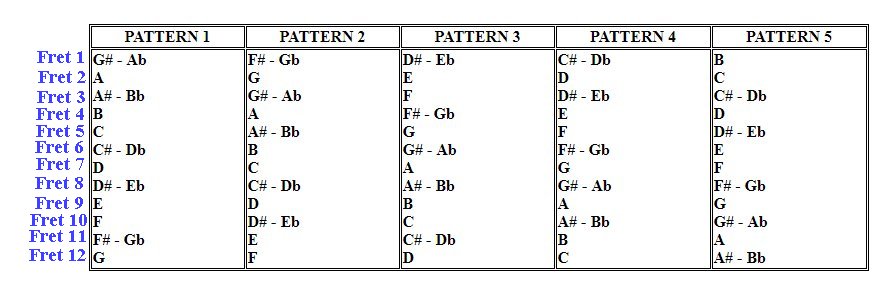From: asf0@comcast.net Alice Franceschini (new email as of August 5, 2006)
Date: June 19, 1997 Revised Sept 13, 1998 Revised September 14, 2001
Revised August 1, 2019
Subject: Lead Guitar - How to play
This information was learned, gathered, compiled by me
Prints about 5 pages.
LEAD GUITAR - HOW TO PLAY
Here is the overview of this document's intent. For those who wish to learn
how to play lead guitar fast with little or no music theory.
Lead Guitar is based on five patterns. Learn these patterns so you can play them without
looking at written notation. Start with pattern 1. These patterns are the minor scales too. Location of those minor scales please.
Take me to the Patterns
You also need to know what key these patterns are when you start moving them around the fretboard.
Take me to the Key Table
For those what want a bit more, read on, friends.........
Find pattern 1 on your guitar. When you play pattern 1 starting on fret 1 you are in the key of Ab/G#.
When you play pattern 1 beginning on fret 2 you are in the key of A. (You are moving up one fret)
When you play pattern 1 on fret 3 you are in the key of A#. Get the idea? If not, see the tab below.
As you go up the neck\frets you go sharp (go up in key or note).
If you go down the neck\frets you flatt (go down in key or note). Now record a series of Ab
guitar chords strums. Just down strokes will work. Record a minute or so that. Now rewind
and play it back. Now play pattern 1 on fret 1 (just play it up and down the notes in time with what you just
recorded). Rewind and now mix up the notes and try to develop a melody. Good.
Later try bending, slurring, hammering on notes in the patterns.
Learn and memorize the patterns instead of indiviual notes for now. Get use to 'pattern 1 at
fret 1 is Ab' 'pattern 1 at fret 2 is A' kind of learning.
Learning these fundamentals works for all genres or kinds of music lead guitar work.
(Genres are country, rock, jazz, blues and so on.)
Learn these five patterns by heart and lead guitar becomes less of a mystery
and as an added bonus you are also learning patterns for the bass guitar.
There is no music theory that supports Cb, B#, E# or Fb and so this document
doesn't take them into consideration.
You may want to look at "How To Transpose" document sometime.
You can download it from the same area you downloaded or viewing this document.
Cb is B and Fb is an E B# is C E# is F. Just look at a piano keyboard.
There is no black key between B and C or E and F
This should be proof enough of music theory does not support them.
You can flatt a C as a verb but it will never become a Cb it will always be a B.
You can sharp an E but that don't make it E#, it's an F Music theory does not
support taking a whole note and making it a half note no matter who you talk to.
The following are definitions used in this document.
UP The note goes higher in pitch (higher up the guitar neck)
DOWN The note goes lower in pitch (lower down the guitar neck)
SHARP # used when you go UP the scale (higher up the guitar neck)
FLATT b used when you go DOWN the scale (lower down the guitar neck)
In other words. Basically, sharps go up the fret\scale and flatts go down the fret\scale
But you are playing an F# and a Gb at the same time no matter where on the guitar fretboard you find
a F# or Gb.
Yes, two names for the same sounding note. This is called an associated note.
F# is also a Gb Gb is a F# It's one note with two names.
The basic understand is a sharp or flatt tells you what you do with the note, go up a fret or down.
Basic music theory rule says you can not repeat the same note in a scale. So there are times you
can run into a scale when this two name system works things out. You can't use G G# but you can use G Ab
in notating your sheet music creation.
If you see a flatted note then there is an associated sharp.
Ab is G#
If you see a sharp note then there is an associated flatt.
G# is Ab
There is no associated key with a whole notes like A or B ect.
A is A
B is B ect.
KEY TABLE read as columns
Rows are frets 1 to 12. Pattern 1 in it's 1st row would be G#\Ab, the 2nd row
under Pattern 1 would be in the key of A and so on. This is now an image and not html
code so you can easily download this image.
How to read this KeyTable.
This table is in rows and columns. The rows are frets and so marked.
Columns are the Key the Patterns are in when you play that pattern beginning
on that fret.
EXAMPLE:
When you start one of these patterns on the 1st fret, you will be in that key listed
in that column.
Look at the first column, Pattern 1. The first row is G# - Ab. When you
start Pattern 1 on the first fret you will be in that key. Play this pattern
beginning on the 12th fret you are in the key of G.
Here's some fun. Record a chord progression of A, D and E. Now play it back and
while your recording is playing the A chord you play a melody or random notes
in pattern 1 on the second fret. When the song changes to
the D you play pattern 1 on seventh when in E run on the ninth fret
or pattern 2 or any of the other patterns that are in the correct chord.
Example Pattern 4 on the 9th fret is A
Pattern 5 on 4th fret is D
Pattern 3 on 2nd fret is E
For the advanced lead player. It's true you do not have to jump all over
the neck just to whack out a lead for a three chord song. Look again at the
diagram. See Pattern 1 at fret 2 is A
Pattern 4 at fret 2 is D
Pattern 3 at fret 2 is E
The whole lead can be made at the second fret.
Remember.......
Lead guitar is imagination played on this fundamental foundation.
THE 'PATTERNS ON THE GUITAR NECK' TAB
THIS TABLATURE IS WIDELY USED ON THE INTERNET.
------ represent the strings. The numbers represent the frets where you press the string.
All patterns shown are in their first positions but these patterns can be played
anywhere on the guitar neck so they can be played in any key.
If you want C from that C#, just go down one fret and you are in C with that same
pattern. C# when you go up one fret, you will now be in D.
This is now an image so you easily download it.
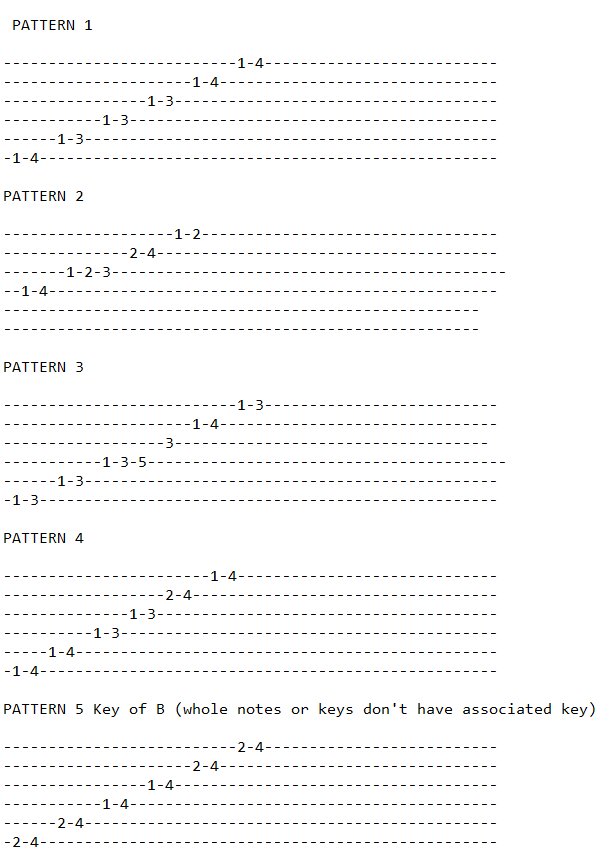 Here's another image showing all of the 5 patterns in a different way.
Here's another image showing all of the 5 patterns in a different way.
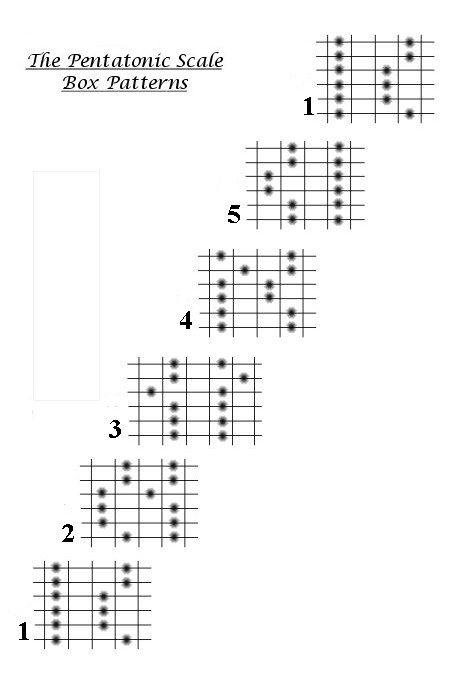 EXAMPLES OF 1ST AND 2ND FRET WITH PATTERN 1
Whole notes (C and E) can only be sharped, never flatted. C can be sharped and it becomes a C#
but when you flatt a C, it does not become Cb it becomes a B. The same with F, you can
sharp F and it becomes a F# but when you flatt an F, it becomes an E not a Fb. If you see
a bbF that would be an Eb note as there is no noun of double flatt F, it can only be a verb.
THE TAB BELOW - Now a download image.
EXAMPLES OF 1ST AND 2ND FRET WITH PATTERN 1
Whole notes (C and E) can only be sharped, never flatted. C can be sharped and it becomes a C#
but when you flatt a C, it does not become Cb it becomes a B. The same with F, you can
sharp F and it becomes a F# but when you flatt an F, it becomes an E not a Fb. If you see
a bbF that would be an Eb note as there is no noun of double flatt F, it can only be a verb.
THE TAB BELOW - Now a download image.
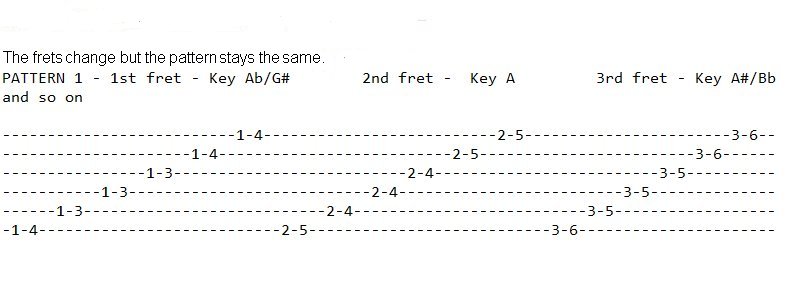 Ok, here's the poop on the location of the minor pentatonic patterns on the guitar fretboard.
When you play G major pentatonic scale, you are also playing the Em pentatonic scale.
Yes, it's that simple. You count backward, G F E, this is how you find out what the
minor key is. A, count backward, A G F, just add an small m to the F, you found your
minor. Yep simple, once you know how. If you are in a minor key, you count forward
E F Gm.
Or you can use the following image.
Ok, here's the poop on the location of the minor pentatonic patterns on the guitar fretboard.
When you play G major pentatonic scale, you are also playing the Em pentatonic scale.
Yes, it's that simple. You count backward, G F E, this is how you find out what the
minor key is. A, count backward, A G F, just add an small m to the F, you found your
minor. Yep simple, once you know how. If you are in a minor key, you count forward
E F Gm.
Or you can use the following image.
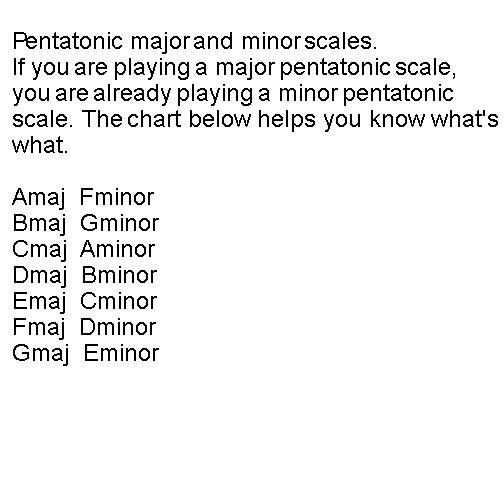
 Here's another image showing all of the 5 patterns in a different way.
Here's another image showing all of the 5 patterns in a different way.
 EXAMPLES OF 1ST AND 2ND FRET WITH PATTERN 1
Whole notes (C and E) can only be sharped, never flatted. C can be sharped and it becomes a C#
but when you flatt a C, it does not become Cb it becomes a B. The same with F, you can
sharp F and it becomes a F# but when you flatt an F, it becomes an E not a Fb. If you see
a bbF that would be an Eb note as there is no noun of double flatt F, it can only be a verb.
THE TAB BELOW - Now a download image.
EXAMPLES OF 1ST AND 2ND FRET WITH PATTERN 1
Whole notes (C and E) can only be sharped, never flatted. C can be sharped and it becomes a C#
but when you flatt a C, it does not become Cb it becomes a B. The same with F, you can
sharp F and it becomes a F# but when you flatt an F, it becomes an E not a Fb. If you see
a bbF that would be an Eb note as there is no noun of double flatt F, it can only be a verb.
THE TAB BELOW - Now a download image.
 Ok, here's the poop on the location of the minor pentatonic patterns on the guitar fretboard.
When you play G major pentatonic scale, you are also playing the Em pentatonic scale.
Yes, it's that simple. You count backward, G F E, this is how you find out what the
minor key is. A, count backward, A G F, just add an small m to the F, you found your
minor. Yep simple, once you know how. If you are in a minor key, you count forward
E F Gm.
Or you can use the following image.
Ok, here's the poop on the location of the minor pentatonic patterns on the guitar fretboard.
When you play G major pentatonic scale, you are also playing the Em pentatonic scale.
Yes, it's that simple. You count backward, G F E, this is how you find out what the
minor key is. A, count backward, A G F, just add an small m to the F, you found your
minor. Yep simple, once you know how. If you are in a minor key, you count forward
E F Gm.
Or you can use the following image.

